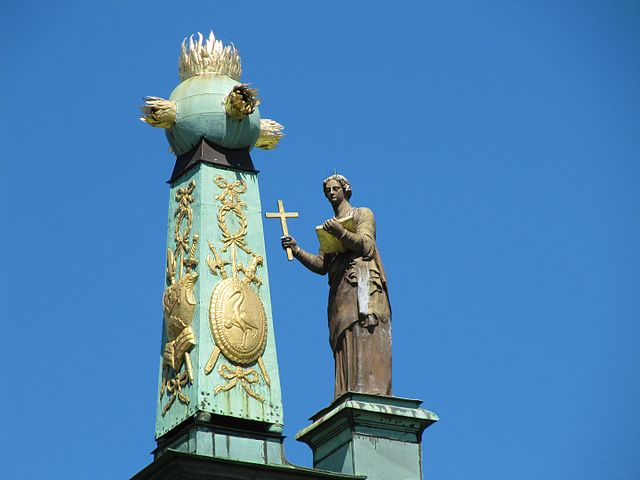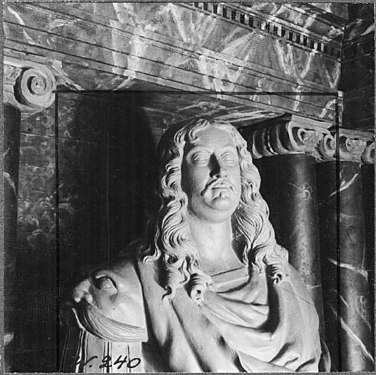Jean Baptist Dieussart
Jean Baptist Dieussart , also Jean Baptist (e / a) Dusart (* around 1630; † after 1683) was a Flemish sculptor who worked in the United Netherlands and mainly in Sweden . He mainly created lead statues , of which only a few have survived to the present day.
life and work
Dieussart was born around 1630 (possibly in Rome ) (a) and was a brother of the architect and sculptor Charles Philippe Dieussart . It appears in Stockholm around 1664 (possibly coming from Germany) when he entered the service of the Swedish Chancellor, Count Magnus Gabriel De la Gardie , who was his main employer and patron until around 1668 . He was accompanied by his wife (who died in Stockholm in 1668 ) and their children from their first marriage, his step-sons Abraham César and Claude Lamoureux (both also sculptors), and their sister Magdalena, who later married the sculptor Johann Gustav Stockenberg .
Dieussart was one of the first exponents of the free-standing Baroque sculpture style in Sweden (some sources cite him as Sweden's first modern sculptor), and his work is also cited as an example of a Renaissance- inspired pseudoclassicism . He mainly created statues for which he used various materials, although the majority of his known works were made of lead or gilded lead . Only a few works by Dieussart still exist, possibly due to material fatigue and the softness of the lead.
For Läckö Castle , he created busts of various members of the De la Gardie family as well as two large statues of Magnus Gabriel De la Gardie and his father Jakob (originally intended for Karlberg Castle , for whose gardens Dieussart also created decorative sculptures), which were later moved there .
Dieussart created several statues, including a replica of a classic Diana statue , to equip another castle of the De la Gardie family, the Makalös city palace . He also created several sculptures for the gardens and fountains of Jakobsdal Castle (now Ulriksdal) , probably with the assistance of his step-sons.
In 1667 he was commissioned by De la Gardie to create lead sculptures for the roof of the Riddarhuset (which was completed between 1660 and 1674 by the architect Jean de la Vallée ), which he delivered in 1668, whereupon he was commissioned by Heinrich Lichtenberg for the northern and To complete the southern portals of the building, which he was still working on in 1669.
Between 1671 and 1672 his stepson Abraham-César was his successor as court sculptor in the service of De la Gardie. It is believed that Dieussart was employed in his stepson's workshop until 1672, and that he may have returned to the Netherlands after that. Swedish records mention him again in 1677, (b) and by 1679 he returned to the Swedish heartland, likely to return to the service of De la Gardie. His whereabouts after 1680 and the time and place of his death are unknown. (c)
Famous works
- Statues "Amor Dei" and "Amor Patriae" on the roof of the Riddarhuset.
- Sculpture group "Perseus and Andromeda" in the park of Jakobsdal Castle (no longer available).
|
Other works ascribed to him
- Lead statues of Magnus Gabriel and Jakob De la Gardie, which were originally made for Karlberg Castle, but were then placed at Läckö Castle, and which were later given a place in the De la Gardie burial chapel in the Varnhem monastery church .
|
|
literature
- Dusart I. Dieussart, Jean Baptiste . In: Theodor Westrin, Ruben Gustafsson Berg, Eugen Fahlstedt (eds.): Nordisk familjebok konversationslexikon och realencyklopedi . 2nd Edition. tape 35 : Supplement: Cambrai – Glis . Nordisk familjeboks förlag, Stockholm 1923, Sp. 414 (Swedish, runeberg.org ).
- Dusart (Dieussart), Jean Baptist . In: Ulrich Thieme (Hrsg.): General Lexicon of Fine Artists from Antiquity to the Present . Founded by Ulrich Thieme and Felix Becker . tape 10 : Dubolon – Erlwein . EA Seemann, Leipzig 1914, p. 226 ( Textarchiv - Internet Archive ).
Individual evidence
- ↑ a b c d e f g h i j Bertil Waldén: Jean Baptista Dieussart . In: Svenskt biografiskt lexikon . 1945 (Swedish, riksarkivet.se ).
- ↑ a b c Bertil Waldén: Nicolaes Millich och hans krets: study i den karolinska baroque sculptural construction . Saxon & Lindströms förlag, Stockholm 1942 (Swedish, limited preview in Google book search).
- ↑ August Hahr: Konst och konstnärer vid Magnus Gabriel de La Gardies hof: bidrag till den svenska konstforskningen . In: Skrifter utgivna av Kungl. Humanistiska Vetenskapssamfundet i Uppsala . tape IX . Akademiska Bokhandeln, Uppsala 1905 (Swedish, archive.org ).
- ↑ a b Jean Baptiste Dieussart. In: StockholmGamlaStan. 2017, Retrieved April 7, 2019 (Swedish).
- ^ A b Erik A. de Jong: Of Plants and Gardeners, Prints and Books: Reception and Exchange in Northern European Garden Culture, 1648-1725 . In: Michel Conan (Ed.): Baroque Garden Cultures: Emulation, Sublimation, Subversion (= Dumbarton Oaks Colloquium on the History of Landscape Architecture ). tape 25 . Dumbarton Oaks, 2005 (English).
- ↑ a b c d Dieussart, Jean Baptista . In: Nils Bohman (Ed.): Svenskahaben och kvinnor. Biography uppslagsbok . 2. CF. Albert Bonniers förlag, Stockholm 1944, p. 262 (Swedish, runeberg.org ).
- ↑ Gustaf Upmark: The Renaissance architecture in Sweden, 1530-1760 . Gerhard Kühtmann, Dresden 1900, p. 99 ( archive.org ).
- ↑ Göran Axel-Nilsson: Makalös: fältherren greve Jakob De la Gardies hus i Stockholm (= Stockholm monograph . Volume 51 ). Liber, Stockholm 1984 (Swedish, stockholm.se ).
- ^ A b Bernard Samuel Myers: Encyclopedia of World Art . tape 13 . McGraw-Hill, 1959, pp. 396-397 (English).
- ^ Sverige (art) . In: Johannes Brøndum-Nielsen, Palle Raunkjær (ed.): Salmonsens Konversationsleksikon . 2nd Edition. tape XXII . JH Schultz Forlagsboghandel, Copenhagen 1927, p. 752 (Danish, runeberg.org ).
- ^ A b Monica Eriksson: Skulpturerna på Riddarhusets tak: en ikonologisk studie . In: Stadsvandringar . 13, 1990, pp. 50-59.
- ^ Paul Campe: The stone portals of the 17th and 18th centuries in Riga and the Rigas sculptors and stonemasons of that time . In: Meeting reports of the Society for History and Archeology in Riga. Lectures from 1932 and 1933 . E. Bruhns, Riga 1934, p. 14 ( handle.net ).
- ↑ Wilhelm Neumann (ed.): The medieval Riga, a contribution to the history of North German architecture . Society for History and Archeology of Riga, Riga 1892 ( riga-digitalis.eu ).
- ↑ Bohumír Indra: Dussart (Dusart), Johann Baptista . In: General Artist Lexicon . The visual artists of all times and peoples (AKL). Volume 31, Saur, Munich a. a. 2001, ISBN 3-598-22771-X , p. 258.
- ↑ Riddarhus . In: Theodor Westrin, Ruben Gustafsson Berg (eds.): Nordisk familjebok konversationslexikon och realencyklopedi . 2nd Edition. tape 23 : Retzius – Ryssland . Nordisk familjeboks förlag, Stockholm 1916, Sp. 228 (Swedish, runeberg.org ).
- ↑ Ralph Edenheim, Ingrid Rosell: Varnhems klosterkyrka (= Sveriges kyrkor: konsthistoriskt inventarium ). Riksantikvarieämbetet, 1982 (Swedish, diva-portal.org ).
| personal data | |
|---|---|
| SURNAME | Dieussart, Jean Baptist |
| ALTERNATIVE NAMES | Dusart, Jean Baptiste |
| BRIEF DESCRIPTION | Flemish sculptor in Sweden |
| DATE OF BIRTH | around 1630 |
| DATE OF DEATH | after 1683 |





